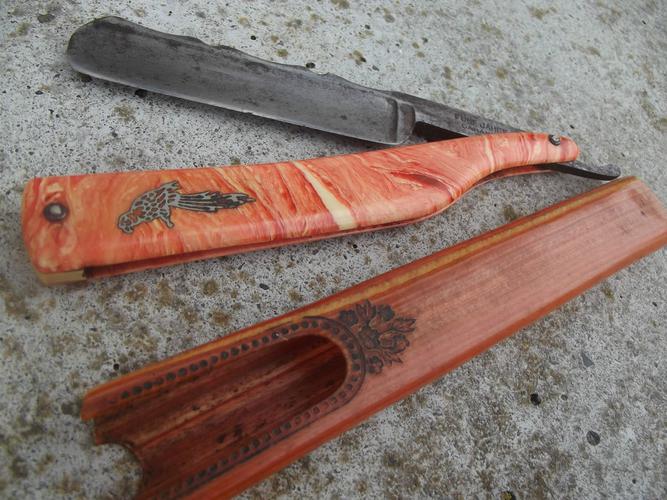Results 11 to 17 of 17
-
06-29-2014, 03:54 AM #11
-
06-29-2014, 04:10 AM #12Senior Member




- Join Date
- Nov 2012
- Location
- Across the street from Mickey Mouse in Calif.
- Posts
- 5,320
Thanked: 1184
You could go with a nice wood or find something made of acrylic sheet that thickness and cut the scales out of that. What you have does not look like cell rot has affected the blade by the pattern showing. All depends on what you want it to look like when done and what you can find to make scales out of.
Good judgment comes from experience, and experience....well that comes from poor judgment.
-
06-29-2014, 04:18 AM #13Senior Member


- Join Date
- Nov 2010
- Location
- Pequea, Pennsylvania
- Posts
- 2,290
Thanked: 375
I'm all for keeping the originals, polish them up and repin
CHRIS
-
06-29-2014, 09:39 AM #14


I have this similar type travel razorSaved,
to shave another day.
-
07-02-2014, 11:02 PM #15
-
07-03-2014, 12:07 AM #16

Just throwing out an idea. If the celluloid is not breaking down yet. Why not seal what he has? A couple of coats of polyurethaine should be findable in Sweden. Then you could keep a thin coat of mineral oil or petrolium jelly on the blade to protect it. If it aint broke dont fix it. This solution which is just an idea . Senior people who know more about celluloid please jump in. If the celluloid isnt in decay prevent it by sealing in from oxygen. Trace the scales now for possible later use. but this option would put the blade back in service plus keep it all original, plus its what this member can easily get his hands on. Oh and sand and polish your scales before sealing them.
-
07-03-2014, 12:20 AM #17

To repost from the "Celluliod Time Bomb" thread from this year.
But these scales are not in active decay at this time..... and to quote the other thread
The most common type of celluloid degradation is caused by camphor gradually working its way out of the product. Extreme heat will contribute to this process. This causes embrittlement, and in transparent or translucent items deep crazing will be evident. Items affected this way will crumble completely.
More serious degradation occurs when the nitrocellulose degrades, giving off oxides of nitrogen. These combine with water, usually also present when this reaction takes place, forming nitric acid. This is very corrosive to metal, fabric, paper, etc., and often results in substantial destruction of surrounding materials. The effects are worse when the celluloid products are stored in closed containers. The fumes are more concentrated, and the by-products catalyze further reaction, leading to further damage.
People often wonder whether anything can be done to treat celluloid buttons or other products to prevent these types of degradation. Proper storage, in ventilated containers, without excess humidity or high temperatures, will make degradation less likely. Unfortunately, once it has begun it is impossible to reverse. Many celluloid items are stable, but unfortunately it is not possible to know which these will be, although translucent and transparent celluloids are more prone to degradation initiated by ultraviolet light. (Colouring agents which prevent light transmission through celluloid objects appear to give some protection.) Most factors which make degradation likely are present from the time of manufacture, and only proper storage can minimize their effects. Some of these factors include: the purity of ingredient materials; the rinsing and drying processes, which may leave agents catalyzing degradation in the finished materials; the kneading process, which affects the celluloid structure; stability of added materials; and other manufacturing processes.
Celluloid must be stored in ventilated containers, protected from light and humidity. It must be kept separately from other materials, particularly metals, which are attacked by corrosive products of celluloid degradation. Celluloid buttons should be examined periodically and any showing signs of degradation, or affecting surrounding materials, should be discarded. On the bright side, many celluloid buttons have been around for 100 years without showing any signs of degradation, and with proper storage most will stay sound.


 18Likes
18Likes LinkBack URL
LinkBack URL About LinkBacks
About LinkBacks













 Reply With Quote
Reply With Quote

